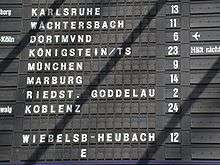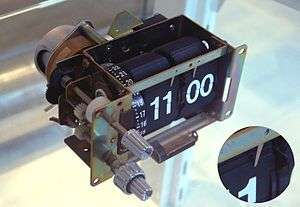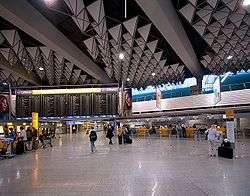Split-flap display





.jpg)
A split-flap display, or sometimes simply flap display, is an electromechanical display device that presents changeable alphanumeric text, and occasionally fixed graphics.
Often used as a public transport timetable in airports or railway stations, as such they are often called Solari boards after display manufacturer Solari di Udine, of Udine, Italy, or in Central European countries they are called Pragotron after the Czech manufacturer.
Split-flap displays were once commonly used in consumer alarm clocks known as flip clocks.
Description
Each character position or graphic position has a collection of flaps on which the characters or graphics are painted or silkscreened. These flaps are precisely rotated to show the desired character or graphic. These displays are often found in railway stations and airports, where they serve as flight information display system and typically display departure or arrival information, although digital equivalents are far more common now.
Sometimes the flaps are large and display whole words, and in other installations there are several smaller flaps, each displaying a single character. The former method is limited to the words it can display on the flaps, while the latter system is not, and output messages can be changed without the need for the addition or replacement of flaps, although images cannot. In the example image on the right, the destinations in the centre of the picture are split into characters, while the messages left and right of these occupy one flap each.
During a power loss or disruption the display will freeze. At first this may be an advantage because the information is still correct. When the information becomes outdated it might be worse than no information.
Flip-dot displays and LED display boards may be used instead of split-flap displays in most applications. Their output can be varied more easily (by reprogramming instead of replacement of physical parts in the case of graphics) but they suffer from lower readability. They also can refresh more quickly, as a split-flap display often must cycle through many states.
Advantages to these displays include:
- high visibility and wide viewing angle in most lighting conditions
- little or no power consumption while the display remains static
- Distinct metallic flapping sound draws attention when the information is updated.
The Massachusetts Bay Transportation Authority has designed the new LED replacements for its aging Solari boards at North Station and South Station to emit an electronically generated flapping noise to cue passengers to train boarding updates.[1]
Many game shows of the 1970s used this type of display for the contestant podium scoreboards. Usually, the flip was left-to-right on a vertical axis, although up/down on a horizontal axis was not completely unknown. Early seasons of the game show Family Feud used a split flap display as part of the game board (subsequent seasons used more modern digital displays, and eventually simply used a large digital flat screen monitor). The game board on the Nickelodeon game show Make the Grade was a 7x7 split-flap display, used to display subjects and wild cards, as well as tracking contestants' progress. The television game show Chain Reaction on GSN features computer-simulated split-flap displays to display the various words in a chain.
In Italy, split-flap displays have also been occasionally used as destination signs for transit vehicles, there was also a brief vogue for them in the United Kingdom in the mid 1980s.[2]
Operational boards in transport terminals and businesses
The boards are currently in use at the following stations:
Australia
- Melbourne Airport (Melbourne Tullamarine Airport, IATA Code MEL). Located in T2 at the Qantas First Lounge (international terminal).
- Sydney Airport (IATA Code SYD). Located in the Qantas First Lounge.
Belgium
- Brussels Airport Located in the departure hall.
China
Shangai Starbucks Roastery. Lists the featured coffee beans on a split flap display installed by Solari di Udine S.P.A.
France
Some railway stations in France still have one or several split-flap displays, Strasbourg, Nantes and Toulouse-Matabiau stations.
Germany

- Frankfurt Airport (Flughafen Frankfurt am Main, IATA Code FRA) has Solari boards throughout the airport, still in use as of December 2016. Each row ends with a pair of green and red lights which flash to indicate that flight is boarding. They indicate each flight's destination, its flight number and carrier, and its departure gate and time.
- Platform split-flap displays are used across the Deutsche Bahn network.
Greece
In Greece, these displays are still widespread. Most airports and train stations have one, most notably the Athens International Airport, which has two enormous displays of this kind. Bus stops, tram stops as well as the stations of the Athens Metro and the Proastiakos Commuter Rail System of Athens use electronic displays.
Hungary
- Budapest Liszt Ferenc International Airport at its check-in and arrivals halls.
India
- Kolkata Airport. Was prevalent in old domestic and international terminals. Recently changed to a fully electronic display at the integrated airport.
Italy
- Roma Termini. Boards located after the ticketing area above the track entrances. In addition, most RFI stations had split-flap display boards, now substituted by LED displays.
- Milan Malpensa Airport. Board located in the check-in area.
- Milan. Board located in the first italian Starbucks shop.
- Trieste Airport. Board located in the check-in area.
Philippines
- Ninoy Aquino International Airport (Manila International Airport). Terminal's biggest timetable. In Terminal 1 Departures level. Over check-in desks and lobby.
Romania
- Otopeni Airport (Bucharest Henri Coandă International Airport) has Solari boards in the international departure area, including a pair of red lights on each row which flash to indicate an important message such as "now boarding".
Serbia
- Belgrade Airport (Belgrade Nikola Tesla Airport, IATA Code BEG) has Solari boards on both levels of the departure area, still in use as of June 2013. Each row ends with a pair of red lights which flash to indicate that the flight is boarding or there is some other change in status. They indicate which destination a flight is to, its flight number and carrier, and its departure gate and time.
Singapore
- Singapore Changi Airport (Singapore Changi Airport, IATA Code SIN). Terminal 2 (Departures).
Sri Lanka
- Bandaranaike International Airport (Bandaranaike International Airport, also known as Katunayake International Airport and Colombo International Airport, IATA Code CMB). Terminal 1.
Switzerland
- Most major railway stations in Switzerland still have split-flap displays in operation. While displays on platforms are gradually being replaced by liquid-crystal displays, the big general departure boards in the concourses of most major stations remain split-flap due to better readability in comparison with digital displays. In recent years, some stations even got newly equipped with split-flap displays or received a new model replacing a dated one. The main split-flap departure board on the concourse of Zürich HB was decommissioned and removed on October 18, 2015, to be replaced with a new and larger LED display.[3]
Taiwan
- Taipei Railway Station originally planned to remove both of its split-flap displays during a renovation in 2011. However, only one board was removed in answer to the call for preservation by local rail enthusiasts. As of 2015, both spit-flap and LED displays are available in the station and remain fully functional.
United States
- Seattle Starbucks Roastery. Lists the featured coffee beans on a split flap display installed in 2017 by Solari di Udine S.P.A.
- Atlantic City Rail Terminal. Located in the waiting area.
- Jacksonville International Airport in Florida. It is on the second floor, in between the two check-in desks.
- The National WWII Museum in New Orleans, LA has an operating split-flap display showing train departure schedules above a replicated railroad platform in the main atrium.[4]
- Philadelphia's 30th Street Station, lower level only. Mounted above centrally located information desk. To be taken down and replaced with a digital one.[5] Small flip boards located at the head of each track stairway. Upper level (SEPTA Regional Rail) uses monitors.
- San Francisco Ferry Building. Located in the Great Nave, and a new installation (2013) rather than a hold-out from the pre-digital era.
- Secaucus Junction in Secaucus, New Jersey. In the Upper Level Concourse.
- Trenton Rail Station. Two side-by-side low profile boards in over-track concourse. Served by all trains except River Line Light Rail.
Boards no longer in operation
May2003.jpg)
Stations previously equipped with these boards included, amongst others:
Canada
- Montréal–Mirabel International Airport contained these boards, which were removed after the airport's destruction in 2002. Two departures boards are currently being restored and repurposed at Concordia University as a branch of the Montréal Signs Project helmed by Dr. Matt Soar.[6]
Cyprus
- Larnaca International Airport's old terminal contains these boards at both arrivals and departure gates. These boards remain in situ after the closure of the terminal in 2009.
Hong Kong
- Kai Tak International Airport used split-flap display in the departure area until its closure in 1998.
- Hung Hom Station (Formerly Kowloon) used split-flap display at the concourse until its renovation in 2001.
- Stations along MTR Island Line.
India
- Chennai Airport used these in the entrance to its old domestic terminal, now closed.
Macedonia
- Skopje, Solari board above ticket office, displaying a range of destinations in Cyrillic, including former Yugoslavian destinations, such as Kosovo Polje (Косово поле) and Titov Veles (Титов Велес) as well as Western European destinations such as Dortmund (Дортмунд) and Paris Lyon (парис лион). This was out of use as of 2013, and as of August 2015, had been dismantled and dumped by the ticket office. The smaller Solari boards on the platforms are, as of August 2015, in situ, but out of use.
Poland
- Poznań Główny railway station, Solari board (see image) used in the hall of old station building and on platforms until 2012. Replaced by digital displays (see image 1, image 2).
Romania
- Gara de Nord railway station had such a board showing destinations for trains that was removed in 2018, being replaced with a LED board. A previous board was replaced in the 1990s, which used to show destinations for other cities that were not serviced at the time, but were used in the 1980s.
United Kingdom
- London Charing Cross, split into two sections with promotional images on destination blinds and up to two calling points per blind, operator shown below calling points, however as of 18 July 2007 these have now been dismantled and taken away to be replaced by the new LED boards like those used at Waterloo and Victoria.
- London Liverpool Street, taken out of service September 2007. A live webcam used to broadcast frequently updated images of this board, but was replaced by a cessation announcement in 2007.[7] The board, pictured, was blue coloured, with one destination per blind, operator above calling points, and could show a range of special messages, including "Boat Train", "Special Service", "International", "Stansted Express" and "This train has been replaced by a substitute road service".
- London Victoria, replaced November 2004
- London King's Cross, replaced in the early 2000s
- Edinburgh Waverley, replaced by an LED departure board
- Glasgow Queen Street
- Glasgow Central
- Birmingham New Street, replaced by LCD screens. The large clock from the board survived above the gateline, with the remaining panels replaced by advertising until the station extension was opened in 2012.
- Manchester Piccadilly, replaced by LCD screen in 2001, as part of the station redevelopment.
- Brighton, replaced by an LED display. A substantial part of the board has been preserved by the Network SouthEast Railway Society.[8]
- Reading
- London Waterloo, replaced by LCD units in the early 2000s, still there out of use until December 2006, when it was taken down to make way for an LED departure board that became operational in March 2007.
- London Paddington, was situated across the platforms and used to carry advertisements on the back, facing arriving passengers.
- Watford Junction, black coloured, full flip columns for Silverlink County services to Northampton, Southern services to Gatwick Airport, and Virgin Trains West Coast and First ScotRail services to North Wales, the North-West and Midlands of England and various destinations in Scotland. However, for Silverlink Metro services to London Euston and Silverlink County services to St Albans Abbey the calling points are fixed and only the time of the next train is changeable, because all trains call at the same stations.
- Woking
- Esher, removed in early 2000s. Controlled from ticket office
United States
- Baltimore Penn Station. (replaced by LED board January 2010)[9]
- Boston South Station. Main lobby, one each for Amtrak and the MBTA, replaced in 2010 by a single LED one.
- Dulles International Airport had a split-flap display from airport opening in 1962 until circa 1991, when the main terminal was expanded.
- New Carrollton Amtrak Station. (Removed in January 2010.)
- New Haven Union Station. Above stairway to platform concourse. Combined Metro-North and Amtrak. Replaced on October 19, 2014, and donated to Danbury Railroad Museum.
- New York City's Grand Central Terminal, replaced by LCD units made by Solari di Udine during reconstruction of the terminal.
- New York City's Penn Station also featured these boards in both the Amtrak portion and the Long Island Rail Road (LIRR) portion. The board in the Amtrak portion, which showed departure information, was replaced in 2000 by an LCD board. The boards in the LIRR portion featured departing trains as well as boards at the head of each stairway to platforms for tracks 13 through 21, which displayed the stops and connections associated with the posted train. These were replaced over a period of several weeks between February and April 2006. The new signs, also made by Solari di Udine, use a combination of LCD and LED technology.
- New York's Museum of Modern Art has a Solari flap display board in its permanent collection, on display in the design wing. The board itself works, and displays the original flight departure data for museum visitors (though reset to EST). The board was originally used in Milan's Malpensa Airport.[10]
- Newark Penn Station. In waiting area located above entrance to track concourse. The board was taken out of service around 10/3/2014 and is to be replaced by an electronic board; it was removed on 3/30/2015.
- Providence Station. Located in waiting area, replaced in late 2016 in favor of digital monitors.[11]
Spain
- Barcelona Sants train station.
- Madrid Chamartin railway station
Switzerland
- Aarau[12]
- Bern
- Biel
- Brig (SBB display inside the main hall)
- Chur
- Fribourg
- Genève-Cornavin
- Genève-Aéroport
- Lausanne
- Luzern
- Neuchâtel
- Olten
- Winterthur
- Zürich HB
The Netherlands
Since the 1980s, all train stations in The Netherlands except those with very low passenger numbers had spit-flap displays on all platforms providing detailed information about the upcoming train. The larger train stations also featured displays in this style near staircases and entrances, and the busiest stations had large overview displays in the main hall, e.g. at Amsterdam Centraal, Utrecht Centraal and Rotterdam Centraal. Between 2010 and 2012, they were all taken out of service. Most spit-flap indicators have been replaced by LCD displays, in some cases LED was used where direct sunlight would impact the readability too much.
Non-informational uses
The aesthetic appeal of the displays is such that they have also seen use in purely artistic forms, such as in Pedestrian Drama, contemporary artwork using this display technology, and art by Juan Fontanive, who has used the mechanism extensively since 2005.
The album cover for The Enemy's album We'll Live and Die in These Towns is based on the Solari design seen at British railway stations.
Philadelphia's Mural Arts Program used a Split Flap to display welcome messages to the many guests as they walked into The Fillmore, as well as to display messages of recognition to honorees, award winners, sponsors, and more.[13]
Patents
- U.S. Patent 3,501,761 Remote-Controlled Display Device for Selectively Displaying Signs or Words
References
- ↑ Mac Daniel (2006-04-06). "Nostalgia for noise at South Station - The Boston Globe". Boston.com. Boston Globe Media Partners, LLC. Retrieved 2014-04-30.
- ↑ "Eastern National Olympian Coach".
- ↑ Ruedi Baumann (2015-10-19). "Sie ist weg". Retrieved 2015-10-19.
- ↑ "WWII Museum Protects Legacy of Those Who Served". 2016-02-12. Retrieved 2017-11-21.
- ↑ Mark Dent (2016-08-25). "Amtrak to replace 30th Street Station's iconic flipping departures sign". Retrieved 2016-08-29.
- ↑ Soar, Matt. "Solari Displays and Flight YMX". Solari Displays and Flight YMX. Retrieved 7 July 2016.
- ↑ "Liverpool Street Live - Web Cams, Special Announcement - Cessation of Web Cam Service". Archived from the original on September 14, 2007. Retrieved August 24, 2017.
- ↑ Network SouthEast Railway Society. "Brighton 'Solari' Train Indicator Board Saved by NSERS". Archived from the original on 2013-11-04. Retrieved 2013-11-04.
- ↑ Michael Dresser (2010-03-22). "Amtrak | At Penn Station, the sign no longer goes clackety-clack". baltimoresun.com. Baltimore Sun. Retrieved 2014-04-30.
- ↑ Smith, Robert A. "MoMA's New Home, for Better and Worse". New York Times. Retrieved 30 April 2014.
- ↑ Anderson, Patrick. "SIGN OF THE TIMES: Old-fashioned departure board will be replaced at Providence Amtrak station". Providence Journal. Retrieved 17 February 2017.
- ↑ http://www.sbb.ch/en/group/the-company/projects/upgrading-the-rail-network/national-projects/modernisierung-generalanzeiger.html%5Bdead+link%5D
- ↑ "Split Flap @ Wall Ball". Retrieved 25 July 2017.
External links
| Wikimedia Commons has media related to Split-flap displays. |